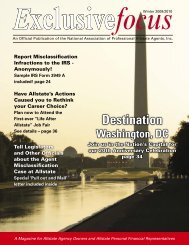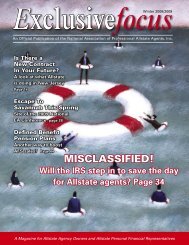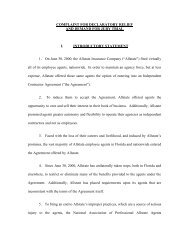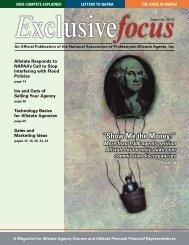Exclusivefocus Spring 2013 - National Association of Professional ...
Exclusivefocus Spring 2013 - National Association of Professional ...
Exclusivefocus Spring 2013 - National Association of Professional ...
You also want an ePaper? Increase the reach of your titles
YUMPU automatically turns print PDFs into web optimized ePapers that Google loves.
feature<br />
Errors and Omissions – What You Don’t<br />
Know Could Cost You<br />
By Jim and Nancy Fish<br />
Agents under contract with Allstate<br />
are required to maintain<br />
Errors and Omissions (E&O)<br />
insurance with a minimum per claim<br />
and aggregate limit <strong>of</strong> $1 million.<br />
According to the R3001 EA Manual,<br />
all R3001 agents – with the exception <strong>of</strong><br />
those in New York State – must obtain<br />
E&O insurance through broker CalSurance,<br />
with coverage provided by Fireman’s<br />
Fund Insurance Company.<br />
The policy period for the Allstate<br />
agent group renews each year on October<br />
1st. Agents are required to purchase<br />
the renewal policy online via the Cal-<br />
Surance website by a specified deadline,<br />
typically around September 21st. There<br />
are two payment options: agents can either<br />
pay in full, or pay in three installments<br />
via ACH, the last <strong>of</strong> which is due<br />
by November 1st.<br />
If an agent fails to fulfill his obligation<br />
to renew the policy by the deadline, Cal-<br />
Surance will notify Allstate and they will<br />
pay the premium on the agent’s behalf.<br />
The full premium, plus a 25% “processing<br />
fee” will then be deducted from the<br />
agent’s commission until the premium<br />
and processing fee are paid in full.<br />
New agents are required to purchase<br />
the coverage at least 15 days prior to<br />
their appointment date. The premium is<br />
prorated and must be paid in full.<br />
Changes in company claims<br />
handling procedures are<br />
unconfirmed, but…<br />
Agents have reported a large increase<br />
in the number and types <strong>of</strong> E&O claims<br />
that have been turned over to CalSurance<br />
in the past two years. Several agents who<br />
have been involved in recent E&O incidents<br />
have been told they are responsible<br />
for binding unacceptable risks, regardless<br />
<strong>of</strong> the fact that the company accepted the<br />
risk at the time <strong>of</strong> the transaction and<br />
upon subsequent renewals.<br />
According to the agents, Allstate informed<br />
CalSurance that it incorporates<br />
underwriting guidelines into technology<br />
preventing agents from submitting<br />
unacceptable risks on new business applications,<br />
but that the same technology<br />
does not exist in the policy endorsement<br />
system. One example is the ineligible vehicle<br />
list, wherein the new business application<br />
risk assessment alerts the agent<br />
and rejects the application, but when an<br />
agent adds the same vehicle to an existing<br />
policy, it sails right through the system.<br />
An example <strong>of</strong> such a scenario was<br />
detailed in a letter that appeared in the<br />
last issue <strong>of</strong> <strong>Exclusivefocus</strong>.<br />
Another example involved a $20,000<br />
SPP item on a renters insurance policy.<br />
The customer had covered the item on<br />
their homeowners policy for ten years<br />
and when they sold their home and<br />
moved to an apartment, the agent transferred<br />
the ring to their renters policy by<br />
endorsement.<br />
The company then renewed the renters<br />
policy twice before the insured had a<br />
loss. It became an E&O claim because<br />
the amount <strong>of</strong> coverage on the ring was<br />
out <strong>of</strong> proportion to the amount <strong>of</strong> underlying<br />
personal property coverage on<br />
the base policy.<br />
Once a claim is turned over to CalSurance,<br />
they pay the claim and submit a bill<br />
to the agent for the deductible. The consent<br />
clause in the policy leaves the agent<br />
with virtually no recourse.<br />
In its explanation for the 17% rate increase<br />
in 2012, CalSurance stated there<br />
has been a significant increase in claims<br />
in recent years. They also cited the overall<br />
decrease in the size <strong>of</strong> the agency<br />
force as a factor contributing to the increased<br />
rate.<br />
Some agents speculate the increased<br />
claim activity has not only boosted premiums,<br />
but may have also been the impetus<br />
for prompting Fireman’s Fund to<br />
implement a sliding deductible schedule<br />
that became effective with the October,<br />
2011 policy renewal – a change that<br />
could indicate the company’s expectation<br />
that an increasing number <strong>of</strong> agents will<br />
suffer multiple losses going forward.<br />
Prior to the October, 2011 policy renewal,<br />
the deductibles for E&O claims<br />
were $1,000 on Allstate policies and<br />
$5,000 on Expanded Markets policies.<br />
The new sliding deductible schedule<br />
states that the standard policy deductible<br />
16 — <strong>Exclusivefocus</strong> <strong>Spring</strong> <strong>2013</strong>
















